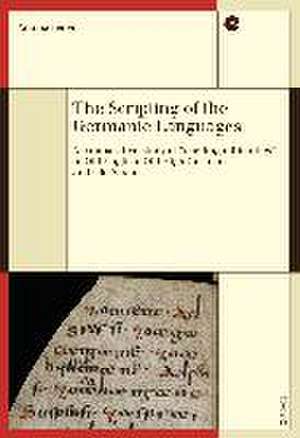The Scripting of the Germanic Languages: Medienwandel - Medienwechsel - Medienwissen, cartea 30
Autor Annina Seileren Limba Engleză Paperback – 13 aug 2014
Preț: 224.70 lei
Nou
Puncte Express: 337
Preț estimativ în valută:
42.100€ • 45.01$ • 35.58£
42.100€ • 45.01$ • 35.58£
Carte indisponibilă temporar
Doresc să fiu notificat când acest titlu va fi disponibil:
Se trimite...
Preluare comenzi: 021 569.72.76
Specificații
ISBN-13: 9783034010306
ISBN-10: 3034010303
Pagini: 268
Ilustrații: zahlreiche Grafiken und Tabellen
Dimensiuni: 154 x 226 x 22 mm
Greutate: 0.45 kg
Editura: Chronos Verlag
Seria Medienwandel - Medienwechsel - Medienwissen
ISBN-10: 3034010303
Pagini: 268
Ilustrații: zahlreiche Grafiken und Tabellen
Dimensiuni: 154 x 226 x 22 mm
Greutate: 0.45 kg
Editura: Chronos Verlag
Seria Medienwandel - Medienwechsel - Medienwissen
Notă biografică
Annina SeilerWissenschaftliche Mitarbeiterin am Englischen Seminar der Universität Zürich. Ehemalige Mitarbeiterin am Nationalen Forschungsschwerpunkt (NFS) 'Medienwandel - Medienwechsel - Medienwissen. Historische Perspektiven'.
Cuprins
THE SCRIPTING OF THE GERMANIC LANGUAGESFrom spoken to written wordThe scripting of West GermanicWest FrankishOld EnglishOld High GermanOld SaxonCorpus of the present studyOld English sourcesEarly Anglo-Saxon charters The Épinal glossaryThe Old English material in Bede's Ecclesiastical HistoryLater Old English sourcesOld High German sourcesEarly Old High German glossesVocabularius Sti GalliPart Ka of the Old High German Abrogans glossaryOHG Isidore translationLater Old High German sourcesOld Saxon sourcesOld Saxon CreedLater Old Saxon sourcesSpelling problemsThe consonants of the West Germanic languagesScripting with the Latin alphabetHISTORICAL GRAPHEMICSMethodological problems of graphemic research"Deficiencies" of writingThe reading processCircular reasoningPhonographic and morphographicMethod and terminologyThe concept of the sound positionCharacters, graphs and graphemesQuantification and the concept of the leading graphSome methodological consequences and problemsGRAPHEMIC ANALYSIS I: MISSING LETTERSOutlineGmc. */w/ in OE, OHG, OSPhonologySound positionsOld EnglishOld High GermanOld Saxon Summary and conclusionsGmc. */þ/ in OE, OHG, OSPhonologySound positionsOld EnglishOld High GermanOld SaxonSummary and conclusionsGmc. */?/ in OE, OS, OHG and Gmc. */k/ in OHGPhonologySound positionsOld EnglishOld High GermanOld SaxonSummary and conclusionsGmc. */b/ in OE, OS, OCFrPhonologySound positionsOld English Old SaxonSummary and conclusionsSpellings for OHG /tz/ and /zz/ (< Gmc. */t/)PhonologySound positionsOld High GermanSummary and conclusionsGRAPHEMIC ANALYSIS II: "SUPERFLUOUS" LETTERSOutlineThe letter kThe letter qThe letter xThe letter zSummary and conclusionRESULTSTowards a history of spellingOld EnglishOverviewContextualisation of analysed textsOld High GermanOverviewContextualisation of analysed texts Old SaxonSummary and conclusionVariability of early medieval scriptsMeasures of variability and consistencyConsistency and the identification of leading graphsSummary and conclusion

















